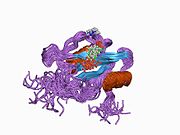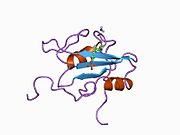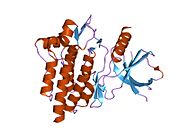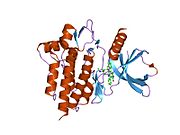Tyrosine-protein kinase SYK
Ensembl | |||||||||
|---|---|---|---|---|---|---|---|---|---|
| UniProt | |||||||||
| RefSeq (mRNA) | |||||||||
| RefSeq (protein) | |||||||||
| Location (UCSC) | Chr 9: 90.8 – 90.9 Mb | Chr 13: 52.74 – 52.8 Mb | |||||||
| PubMed search | [3] | [4] | |||||||
| View/Edit Human | View/Edit Mouse |
Tyrosine-protein kinase SYK, also known as spleen tyrosine kinase, is an enzyme which in humans is encoded by the SYK gene.[5][6][7]
Function
SYK, along with
While Syk and ZAP70 are primarily expressed in hematopoietic tissues, a variety of tissues express Syk. Within B and T cells, respectively, Syk and ZAP70 transmit signals from the B-cell receptor and T-cell receptor.[10] Syk plays a similar role in transmitting signals from a variety of cell surface receptors including CD74, Fc receptor, and integrins.
Function during development
Mice that lack Syk completely (Syk−/−, Syk-knockout) die during embryonic development around midgestation. They show severe defects in the development of the lymphatic system. Normally, the lymphatic system and the blood system are strictly separated from each other. However, in Syk deficient mice the lymphatics and the blood vessels form abnormal shunts, leading to leakage of blood into the lymphatic system. The reason for this phenotype was identified by a genetic fate mapping approach, showing that Syk is expressed in myeloid cells which orchestrate the proper separation of lymphatics and blood system during embryogenesis and beyond. Thus, Syk is an essential regulator of the lymphatic system development in mice.[11]
Clinical significance
Abnormal function of Syk has been implicated in several instances of hematopoietic malignancies including translocations involving Itk and Tel. Constitutive Syk activity can transform B cells. Several transforming viruses contain "Immunoreceptor Tyrosine Activation Motifs" (ITAMs) which lead to activation of Syk including Epstein–Barr virus, bovine leukemia virus, and mouse mammary tumor virus.
SYK inhibition
Given the central role of SYK in transmission of activating signals within B-cells, a suppression of this tyrosine kinase might aid in the treatment of B cell malignancies and autoimmune diseases.[citation needed]
Syk inhibition has been proposed as a therapy for both lymphoma and chronic lymphocytic leukemia.[citation needed] Syk inhibitors are in clinical development, including cerdulatinib and entospletinib.[12] Other inhibitors of B-cell receptor (BCR) signaling including ibrutinib (PCI-32765) which inhibits BTK,[13] and idelalisib (PI3K inhibitor - CAL-101 / GS-1101) showed activity in the diseases as well.[14]
The orally active SYK inhibitor
The Syk inhibitor nilvadipine has been shown to regulate amyloid-β production and Tau phosphorylation and hence has been proposed as a treatment for Alzheimer's disease[16] and has entered phase III clinical trials.[17]
Epithelial malignancies
The role of Syk in epithelial malignancies is controversial. Several authors have suggested that abnormal Syk function facilitates transformation in
Without Syk, the protein it makes, and genetic disruption in a panel of 55 genes thought also to be controlled by Syk, breast ductal carcinoma in situ (breast DCIS, which can become invasive), it is believed that the cancer has a markedly increased tendency to invade and metastasize.[18]
Interactions
Syk has been shown to
- CRKL,[22]
- FCGR2A,[23][24]
- FYN,[25][26]
- Lck,[29]
- LYN,[30]
- PTK2,[31]
- PTPN6,[27][32] and
- VAV1.[19][33][34]
References
- ^ a b c GRCh38: Ensembl release 89: ENSG00000165025 – Ensembl, May 2017
- ^ a b c GRCm38: Ensembl release 89: ENSMUSG00000021457 – Ensembl, May 2017
- ^ "Human PubMed Reference:". National Center for Biotechnology Information, U.S. National Library of Medicine.
- ^ "Mouse PubMed Reference:". National Center for Biotechnology Information, U.S. National Library of Medicine.
- ^ "Entrez Gene: SYK Spleen tyrosine kinase".
- S2CID 54326428.
- S2CID 33774157.
- PMID 28736554.
- PMID 29881386.
- PMID 20467426.
- PMID 20230750.
- PMID 27247756.
- PMID 27641927.
- PMID 27252232.
- S2CID 24168330.
- PMID 25331948.
- ^ Lawlor PB (3 March 2017). "A Phase III Trial of Nilvadipine to Treat Alzheimer's Disease". ClinicalTrials.gov. Retrieved 2017-04-02.
- PMID 24523870.
- ^ PMID 11331248.
- PMID 9857068.
- PMID 12435267.
- PMID 11313252.
- PMID 9268059.
- PMID 11141335.
- PMID 9535867.
- PMID 9169439.
- ^ PMID 10747947.
- PMID 11964172.
- PMID 7539035.
- PMID 7831290.
- PMID 9342235.
- PMID 10072516.
- PMID 8986718.
- PMID 8900182.
Further reading
- Turner M, Schweighoffer E, Colucci F, Di Santo JP, Tybulewicz VL (March 2000). "Tyrosine kinase SYK: essential functions for immunoreceptor signalling". Immunology Today. 21 (3): 148–54. PMID 10689303.
- Fruman DA, Satterthwaite AB, Witte ON (July 2000). "Xid-like phenotypes: a B cell signalosome takes shape". Immunity. 13 (1): 1–3. PMID 10933389.
- Yanagi S, Inatome R, Takano T, Yamamura H (November 2001). "Syk expression and novel function in a wide variety of tissues". Biochemical and Biophysical Research Communications. 288 (3): 495–8. PMID 11676469.
- Tohyama Y, Yamamura H (2006). "Complement-mediated phagocytosis--the role of Syk". IUBMB Life. 58 (5–6): 304–8. S2CID 41684033.
- Schymeinsky J, Mócsai A, Walzog B (August 2007). "Neutrophil activation via beta2 integrins (CD11/CD18): molecular mechanisms and clinical implications". Thrombosis and Haemostasis. 98 (2): 262–73. S2CID 41094726.
External links
- Syk+kinase at the U.S. National Library of Medicine Medical Subject Headings (MeSH)
- Overview of all the structural information available in the PDB for UniProt: P43405 (Tyrosine-protein kinase SYK) at the PDBe-KB.






